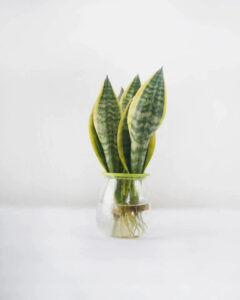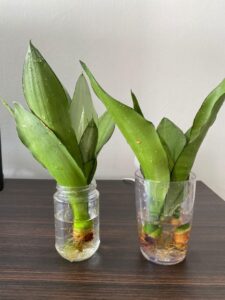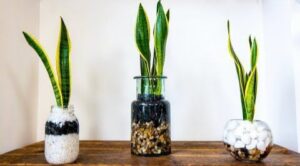Growing Snake Plants in Water is quite easy as this process is free from the mess of soil. Learn all the details in this guide below.
Indoor Sansevierias are incredibly versatile and require minimal effort to care for. They effortlessly complement any type of decor and are perfect for those who prefer not to deal with pots and soil. If you want to keep things simple and try something new, here are all the details on Growing Snake Plants in Water.
Check Best Snake Plant Soil Recipes
Can Snake Plants Survive in Water?

Yes, Sansevieria plants can survive in water. However, it may seem strange because snake plants don’t like to be overwatered, which can lead to root rot and fungal infections.
But you can safely grow snake plants in water if you remember the following points.
Growing Snake Plants in Water
You can grow snake plants in water by using leaf cuttings from an existing plant. It takes about 2-3 months for the roots to become healthy and strong. Once the roots have formed, you can continue growing the snake plants in water.
However, it’s important to note that plants generally grow slower in water compared to soil. This means that if you choose to grow a snake plant in water, it may not show much growth. Still, it can be a beautiful decorative piece to have on a shelf or table.
Learn How to Force a Snake Plant to Bloom
How to Grow Snake Plants in Water?

You can try this procedure at any time of the year in your home:
Things You’ll Need:
- Clean, sharp knife or scissors
- Healthy snake plant
- Vase or glass jar
- Toothpicks
- Water
Propagation
- For growing snake plants in water, choose mature cuttings with vibrant green leaves. Make sure it is free from any signs of disease or pests.
- Ensure to make a clean and neat cut at the bottom of the snake plant cutting. This will greatly improve the chances of successfully growing a new plant.
- Put the snake plant cutting in a clear jar or vase and fill it with non-chlorinated water, making sure to cover the bottom 25 percent of the leaf-cutting.
- If you’re using a small glass, insert toothpicks into the leaves to hold them in place. This will help keep the leaves secure while they are growing in water.
- The root will emerge in around 1-2 months.
Another option for growing snake plants in water is, you can also choose a young snake plant pup with less developed roots. Rinse its roots under running water and place it in a vase of water, following the steps mentioned above.
Note: This method tends to be more successful, but it’s all about trying and experimenting to see what works best for you.
Important Tips for Growing Snake Plants in Water

Light
Snake plants need bright light to thrive, so avoid placing them in dark areas. It’s best to keep them near an east-facing window where they can receive direct sunlight for 2-3 hours in the morning. If that’s not possible, any spot with bright indirect sunlight throughout the day will also work well.
Water
The quality of water is crucial when growing snake plants hydroponically. It’s best to use rainwater, pond, well, or RO water. If you’re using tap water, let it sit overnight before using it. Remember to change the water every 5-7 days or sooner if it starts to look discolored.
Temperature
Snake plants grow best in water when the temperature ranges between 50-95°F (10-35°C). The plant thrives in warm temperatures, preferably above 60°F (15°C) or higher.
Fertilizer
To nourish the plant, use a balanced, water-soluble fertilizer. Adding a small amount of fertilizer, about a pinch, every third or fourth time you change the water is usually sufficient. Alternatively, you can occasionally use diluted aquarium water for feeding, once every few weeks.
Where to Keep Water-Grown Snake Plants?

Place snake plants grown in water on center tables in jars or narrow vases to enhance their beauty. You can also keep them on desks, dining tables, and tabletops to add an elegant touch.
Read about World Water Day
Keep in Mind
- Protect snake plants from cold weather by keeping them away from cold drafts. Avoid placing them near window panes or A/C vents.
- Each time you change the water, make sure to rinse the jar. This will eliminate any fungi or bacteria present on the jar’s surface. Remove any rotten parts or thick brown outer covering from the floating aerial roots.
- To keep the water clean, you can add one or two pieces of activated charcoal to the vase.
Read about Night Owl Snake Plant Care



